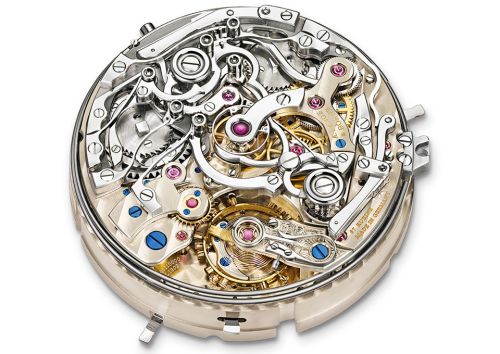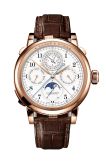A. Lange & Söhne caliber L1902
we may be compensated
if you make a purchase.
| Brand: | A. Lange & Söhne |
|---|---|
| Reference: | L1902 |
| Movement: | Handwound |
| Display: | Analog |
| Diameter: | 40.50 |
| Jewels: | 67 |
| Reserve: | 30 |
| Frequency: | 18000 |
| Date: | Date, Day, Leap Year, Month, Perpetual Calendar |
| Chronograph: | Chronograph, Column wheel, Rattrapante, Foudroyante |
| Hands: | Hours, Minutes |
| Astronomical: | Moonphase |
| Acoustic: | Grande Sonnerie, Minute Repeater, Petite Sonnerie |

L1902 description
Handwound 'Grand Complcation' movement. The readily visible chronograph-rattrapante mechanism merely suggests the overall complexity of the movement: the grande sonnerie and perpetual calendar mechanisms are located beneath it, largely concealed. All movement parts are lavishly finished by hand. Particular emphasis is placed on levers, rockers and springs, which are black-polished by the finisseurs. The latter polishing steps alone require more than a month of manual work. Endowed with solarisation, the mainspring barrel provides a power reserve of 30 hours.
The grande sonnerie is especially daunting for the watchmaker. He is not only responsible for precisely adjusting the switching sequences of the individual parts but also for the richness of the sound. Tuning is performed exclusively by hand and “by ear”. The grand and small strikes automatically indicate the time in quarter-hour intervals. When the slide at 8 o’clock is actuated, the minute repeater will indicate the time to one-minute accuracy. The acoustic time is mechanically sampled from three so-called snails in the middle of the movement. The low-pitched tones indicate the hours, the high-pitched ones the minutes and the double tones the quarter-hours. The striking mechanism has its own spring barrel, which delivers enough power for 24 hours.
With its 248 parts, the split-seconds chronograph mechanism is the most complex ensemble of this watch. Operated by the two push pieces on the top left and right sides of the case flank, it can measure the duration of an event any number of intermediate times. The chronograph and rattrapante functions are controlled by two separate column wheels. A mechanical rarity, the flying-seconds mechanism indicates fractions of a second in a subdial of its own. Its specially designed escapement assembly includes a wheel with 30 teeth and a five-pointed star. These elements allow the hand to perform its movements as fast as lightning and with the utmost precision. The energy needed for this rare additional chronograph function is so considerable that a third spring barrel is needed to deliver it.
The perpetual calendar mechanism emulates the Gregorian calendar. Not only does it know how many days each month has in the course of a year, it is also aware of the fact that February has 29 days in leap years. It needs to be adjusted by one day – in 2100 for the first time – because the Gregorian calendar omits the 29th of February in centenary years that are not divisible by 400. The duration of each month is coded into a 48-segment wheel with recesses that are mechanically sampled by the date switching lever. The deeper the recess, the shorter the month.



